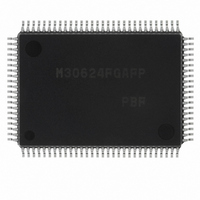M30624FGAFP#U3 Renesas Electronics America, M30624FGAFP#U3 Datasheet - Page 78

M30624FGAFP#U3
Manufacturer Part Number
M30624FGAFP#U3
Description
IC M16C MCU FLASH 100QFP
Manufacturer
Renesas Electronics America
Series
M16C™ M16C/60r
Datasheets
1.M30622SAFPU5.pdf
(277 pages)
2.M30622SAFPU5.pdf
(617 pages)
3.M30622SAFPU5.pdf
(308 pages)
Specifications of M30624FGAFP#U3
Core Processor
M16C/60
Core Size
16-Bit
Speed
16MHz
Connectivity
SIO, UART/USART
Peripherals
DMA, PWM, WDT
Number Of I /o
85
Program Memory Size
256KB (256K x 8)
Program Memory Type
FLASH
Ram Size
20K x 8
Voltage - Supply (vcc/vdd)
4.2 V ~ 5.5 V
Data Converters
A/D 10x10b, D/A 2x8b
Oscillator Type
Internal
Operating Temperature
-40°C ~ 85°C
Package / Case
100-QFP
For Use With
867-1000 - KIT QUICK START RENESAS 62PM3062PT3-CPE-3 - EMULATOR COMPACT M16C/62P/30P
Lead Free Status / RoHS Status
Lead free / RoHS Compliant
Eeprom Size
-
Available stocks
Company
Part Number
Manufacturer
Quantity
Price
Part Number:
M30624FGAFP#U3M30624FGAFP#D3
Manufacturer:
Renesas Electronics America
Quantity:
10 000
Part Number:
M30624FGAFP#U3M30624FGAFP#D5
Manufacturer:
Renesas Electronics America
Quantity:
10 000
DMAC
DMA enable bit
DMA request bit
(1) Internal factors
(2) External factors
Setting the DMA enable bit to “1” makes the DMAC active. The DMAC carries out the following operations
at the time data transfer starts immediately after DMAC is turned active.
(1) Reloads the value of one of the source pointer and the destination pointer - the one specified for the
(2) Reloads the value of the transfer counter reload register to the transfer counter.
Thus overwriting “1” to the DMA enable bit with the DMAC being active carries out the operations given
above, so the DMAC operates again from the initial state at the instant “1” is overwritten to the DMA
enable bit.
The DMAC can generate a DMA transfer request signal triggered by a factor chosen in advance out of
DMA request factors for each channel.
DMA request factors include the following.
* Factors effected by using the interrupt request signals from the built-in peripheral functions and software
* External factors effected by utilizing the input from external interrupt signals.
For the selection of DMA request factors, see the descriptions of the DMAi factor selection register.
The DMA request bit turns to “1” if the DMA transfer request signal occurs regardless of the DMAC's state
(regardless of whether the DMA enable bit is set to “1” or “0”). It turns to “0” immediately before data
transfer starts.
In addition, it can be set to “0” by use of a program, but cannot be set to “1”.
There can be instances in which a change in DMA request factor selection bit causes the DMA request bit
to turn to “1”. So be sure to set the DMA request bit to “0” after the DMA request factor selection bit is
changed.
The DMA request bit turns to “1” if a DMA transfer request signal occurs, and turns to “0” immediately
before data transfer starts. If the DMAC is active, data transfer starts immediately, so the value of the
DMA request bit, if read by use of a program, turns out to be “0” in most cases. To examine whether the
DMAC is active, read the DMA enable bit.
Here follows the timing of changes in the DMA request bit.
Except the DMA request factors triggered by software, the timing for the DMA request bit to turn to “1” due
to an internal factor is the same as the timing for the interrupt request bit of the interrupt control register to
turn to “1” due to several factors.
Turning the DMA request bit to “0” due to an internal factor is timed to be effected immediately before the
transfer starts.
An external factor is a factor caused to occur by the leading edge of input from the INTi pin (i depends on
which DMAC channel is used).
Selecting the INTi pins as external factors using the DMA request factor selection bit causes input from
these pins to become the DMA transfer request signals.
The timing for the DMA request bit to turn to “1” when an external factor is selected synchronizes with the
signal's edge applicable to the function specified by the DMA request factor selection bit (synchronizes
with the trailing edge of the input signal to each INTi pin, for example).
With an external factor selected, the DMA request bit is timed to turn to “0” immediately before data
transfer starts similarly to the state in which an internal factor is selected.
DMA factors (internal factors) effected by a program.
forward direction - to the forward direction address pointer.
_______
_______
SINGLE-CHIP 16-BIT CMOS MICROCOMPUTER
_______
M16C / 62A Group
Mitsubishi microcomputers
75

























